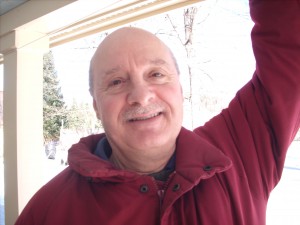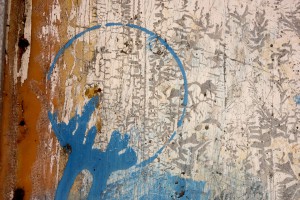Friday
Dharma TeachingsThe Dance of Fear
by Roger Guest
To be a warrior means to live a life without pretense.
In simple terms, this requires an intimacy with reality that leaves no room for self-deception. Once, while giving a talk to a group of about thirty people, I asked the audience to list words and phrases that express fear. At first, people offered obvious synonyms such as ‘nervous’, ‘terrified’, ‘scared’, ‘afraid’, and so on. After that came hesitation, ambivalence, dread, paranoia, worry and panic.
As we explored further, a fascinating mural began to emerge. Voices piped in with subtler tones like coyness, apprehension, wishy-washiness, insecurity, anxiety, aloofness, concern, alarm, trepidation, fright, mistrust, shyness, angst, hyper vigilance, caution, foreboding, uneasiness, timidity, reluctance, and guardedness. Before long we had covered an entire blackboard and it still felt like we were just getting started.
Perhaps our language contains so many words and expressions for fear because when we sense peril it affects us in such a variety of ways. It would be a gross oversimplification to say that the release of adrenalin only means we are driven to fight or flee. In moments of intense anxiety people behave in all kinds of unexpected ways. We might freeze, vomit, scream, laugh manically, dissociate or hide. We might also have the presence to examine ourselves and even find the courage and presence to stay in eye contact with the fear. By simply acknowledging the felt sense of our body in that moment, we might find a way to use the force and momentum of our reaction to regain our balance.
Warriorship has been defined as a constant dance with fear. Until one becomes a truly accomplished dancer any awkwardness in one’s step can be seen as an opportunity to polish one’s character. As a partner, fear pushes us to go deeper and uncover more about ourselves than we might otherwise want to acknowledge or accept. In a dance that leads to the intimate undoing of habitual patterns, it is not by cowering or running away but by stepping out of the shadows that we gain the freedom to fully be. Our willingness to listen to the music of fear defines our life. Learning to feel and to touch the sources of our anxiety requires us to dance as if life depended on it, with confidence and with humor. And we might even emerge with a newfound sense of spontaneous elegance. It is safe to assume there are currents and rhythms embedded in basic goodness, joyous enthusiasm and the development of skill that we have yet to explore.
A warrior’s dedication to wakefulness is not like going to an exercise class only to snack on potato chips on the way home. If we are really interested in authenticity we have to regard our path as serious business. Just as a good samurai sword is not a toy, dancing with fear is neither a hobby nor self-improvement project. When something has the power to expose the truth, it demands respect. Dancing with fear puts us on the spot, not on the defensive.
Fear has its value in the human psyche insofar as it contains wakefulness. But unexamined trepidation is often stored as pockets of rancid pus within our body-mind continuum where it can manifest for years as psychic pain. A heart-broken wife is shocked when her husband casually announces, “I no longer love you, I think we should get a divorce!” in the midst of making dinner. Perhaps, in that moment, time just stops. Arrows of pain and shock stab into vulnerable shoulder muscles and tighten into a knot. Lungs struggle to fill with air in between sobs, and a dam inside her chest breaks.Twenty years later, on a massage table or a therapist’s couch, that stabbing pain is muffled, but still there. It turns out those stinging words have left permanent bruises. Storm after storm and wave after wave of energized thoughts have rolled over tense muscles driving reactive emotional grooves deeper into that neck, chest and stomach. Some healing has happened, but at an unconscious level a few important emotional response mechanisms still seem stuck. Sadly, for that person, the world of intimacy still feels like a mine-field riddled with triggers of past trauma.
We probably all suffer from some degree of post-traumatic stress. Years after an actual event, we still get unexplained headaches or re-experience disturbing dreams or memories that are stirred up in our subconscious minds. Visions in the brain send anxious floods of toxic neurotransmitters cascading through our synapses as if what we are in the midst of remembering was happening for the first time.
As we grow older, our poor old nervous systems still send out all-points-bulletins of alarm that are received by the heart, lungs, colon and aging muscles like electricity from a light switch. Those vulnerable shoulders are still called to alert like tired sentries at their posts. It’s no wonder we are racked with so many aches, pains and illnesses; we have been bracing ourselves against fear’s tyranny for decades. Of course our reserves are diminished; our resolve has been undermined and our trust ransacked for so many years that our bodies have literally forgotten how to relax. Rather than learning to dance with fear we have become experts at running, hiding, cringing or making excuses our whole lives.
Although the energy of fear seems to be routed deep in the past or future, it actually happens within the present moment. Thus, if we are to find our balance, we have to regain a sense of being present here and now. The warrior’s task is to regain enthusiasm for the dance and stop squandering his or her dignity, to notice reactive emotions as they arise and respect their voices. It is not necessary to answer their calls with habitual behaviors. Meditation teaches us to not to assign blame, but rather to reassign our awareness. Such flexibility allows us to appreciate the sparkling fresh quality of fear, bow to it with unadulterated clarity, and dance with integrity.
When we waltz with fear, every gesture and response is a step forward into fearlessness. If terror arises in our throats, we taste it but we don’t swallow. If it moves up our neck to our jaw, we follow it but we don’t yell out. If it tries to take up residence in our shoulders or in our guts, we breathe awareness into those areas and massage them with open curiosity. It may take time to develop the confidence and skill of an excellent dance partner, but as fear passes though us like a wave in a pond we learn to respond with fluidity and aliveness and the dance transforms us. For as we dance, we regain our life-force.As confidence sweeps up the last pockets of resistance and ferrets out the remnants of old insurgencies, we mature. Seeing the futility of further aggression we stop kindling whole new rounds of tyranny and re-open our hearts to others. Fearlessness brings peace and strength to both mind and body. Finally we can look fear straight in the eye and fully inhabit our dignity, smile and step forward into the present moment.
This piece is drawn from a chapter in Roger Guest’s book, The Tender Heart of Sadness.
~~
 Roger Guest is a former Executive Director of Karme Choling (1980-1986), author of The Tender Heart of Sadness (Aventine 2009) and a senior teacher in the Shambhala Buddhist tradition.
Roger Guest is a former Executive Director of Karme Choling (1980-1986), author of The Tender Heart of Sadness (Aventine 2009) and a senior teacher in the Shambhala Buddhist tradition.




















May 22, 2015
Reply
Thank you so much for this wonderful exploration of fear and working with it with courage and mindfulness. Quite a lot of experience and wisdom here.
May 22, 2015
Reply
While I found this piece inspirational, I think it’s worth stressing that one doesn’t march, warriorlike, or even dance, into being present, but rather surrenders into it. There’s a risk, in using inspirational words, of falling into the trap of creating formulas and value judgments about behavior. Aloofness and caution might express fear, but not necessarily. Spontaneity may express panic. Cheerfulness can be a desperate effort to drown out fear. The same is true of enthusiasm, confidence, or any other behavior. After all, who is more fearful of basic space than the enthusiastic power-walker, fresh from assertiveness training, exuding confidence and leadership?
As Dilgo Khyentse, Rinpoche so simply put it (though it’s had varying translations), “the everyday practice is simply to develop a complete acceptance and openness to all situations and emotions”.
May 22, 2015
Reply
Thank you for this article – posted in my here and now to read. Fear/anxiety is a common companion of mine and can slide in the room so silently that I hardly notice I’ve been invaded. It has taken me a long while to even be present enough to notice the point at which it comes to visit. ” It is not necessary to answer their calls with habitual behaviors” and “reassigning our awareness” while dancing with integrity gives me a good focus.
Dancing with integrity gives me an image of doing a waltz. I don’t the steps yet but…..